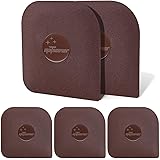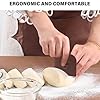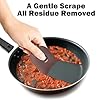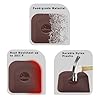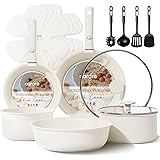Pan Scraper, 5 Pcs Pot Scraper Plastic, Pot Scraper Non Scratch for Cast Iron, Pot and Pan Cleaning, Sturdy Scraper Kitchen Tool
$5.99 ($1.20 / count) (as of November 13, 2025 10:25 GMT -05:00 - More infoProduct prices and availability are accurate as of the date/time indicated and are subject to change. Any price and availability information displayed on [relevant Amazon Site(s), as applicable] at the time of purchase will apply to the purchase of this product.)Ball Wide Mouth Glass Mason Jars with Lids and Bands, Used for Canning, Pickling, Juice, Jam, Jelly, Quart Size 32 Ounce (Pack of 2)
$15.99 ($8.00 / count) (as of November 13, 2025 15:03 GMT -05:00 - More infoProduct prices and availability are accurate as of the date/time indicated and are subject to change. Any price and availability information displayed on [relevant Amazon Site(s), as applicable] at the time of purchase will apply to the purchase of this product.)CAROTE 17pcs Pots and Pans Set, Nonstick Cookware Set Detachable Handle, Induction Kitchen Cookware Sets Non Stick with Removable Handle, RV Cookware Set, Oven Safe
5% OffUnderstanding the Importance of Preheating
Why Preheating Matters
Let me tell you, when it comes to cooking, preheating your pan can make all the difference. Think about it—when you toss ingredients into a cold pan, they tend to stick, resulting in uneven cooking and endless frustration. From my own experience, preheating sets the stage for everything that follows.
When the pan is hot enough, I’ve noticed that it not only helps to sear the meat evenly but also locks in juices, resulting in a flavorful dish. I like to think of my preheated pan as a warm welcome for the ingredients, ensuring they feel right at home.
So, whether I’m whipping up a quick stir-fry or searing a steak, giving my pan a few moments to heat up first is non-negotiable. The results speak for themselves—delicious, perfectly cooked meals that make me feel like a chef.
Benefits of Preheating
The benefits of preheating go beyond just good cooking—it’s about enhancing the flavors and textures of the food. When the heat is evenly distributed right from the start, I find that dishes not only cook faster but more uniformly as well. No one wants burnt spots on their beautiful chicken breast!
A quick sizzle when the food hits the pan? That’s the sound of success, my friends! It means that I’ve created a nice crust on the outside, locking in those tantalizing flavors inside. Plus, it reduces the cooking time, which is always a bonus when I’m hungry.
Let’s also not overlook safety. Cooking in a properly preheated pan reduces the chances of undercooked food. Nobody wants to deal with raw chicken, am I right? Preheating ensures that every component of my dish reaches the correct temperature, making it taste better and safer to eat.
How to Know When Your Pan is Ready
You might wonder how to tell when your pan is hot enough. I tend to place my hand just above the surface; if I can feel the heat radiating off it, that tells me I’m on the right track. It’s a quick and easy method that serves me well.
Another trick I love is the water droplet test. Just a drop of water on a properly preheated pan will dance around and evaporate quickly, signaling that it’s time to start cooking. That sound is like music to my ears, indicating I’m ready to roll!
Lastly, watching my oil or butter shimmer can be a great indicator too. Once they are frantically swirling around, that’s my cue that I can start adding my ingredients for that perfect meal.
Choosing the Right Pan for the Job
Materials Matter
When it comes to pan materials, I’ve learned that not all pans are created equal. Personally, I love using cast iron and stainless steel for their heat retention and non-stick properties. They heat evenly and can take the heat without warping, making them ideal for almost any cooking task.
Non-stick pans have their place in my kitchen too, especially when I’m making eggs or delicate fish. They require a lower preheating temperature, which helps to keep my meals from sticking and ensures a smooth cooking experience.
Using the right material means I can avoid dreaded hot spots. It gives me more control over the cooking process and honestly makes me feel like a real cooking professional! The right pan makes all the difference.
Size Matters
I’ve discovered that choosing the right size pan is just as essential as the material. A small pan can easily become overcrowded, leading to steaming rather than searing. No thanks! I prefer using a larger pan to allow my ingredients enough space to brown beautifully.
If I’m cooking for a crowd, I don’t hesitate to reach for my larger skillet. It keeps the cooking process efficient, and I can get everything on the table in no time. A well-preheated, spacious pan results in even better quality food!
Remember, having the right size pan can also save energy. If you’re using a giant pot for a small sauce, you might as well be trying to catch rain in a teacup. I always choose wisely!
Types of Cooking Techniques
The cooking technique I use also influences pan preheating. Whether I’m sautéing, frying, or searing, understanding how to adjust the heat and preheating time per technique proves invaluable.
For sautéing, a medium-high heat does the trick, bringing just the right amount of splash to my vegetables. On the other hand, when I’m about to throw a steak on the grill, I crank up the heat for that perfect sear. Preheating time might double but trust me, it’s worth the wait.
Considering the cooking technique not only helps with flavor but also maximizes my kitchen skills. Each technique has its little nuances, and I always love learning more to improve my cooking game!
Common Mistakes to Avoid
Preheating for Too Long
I get it; sometimes we want to make sure that the pan is super hot, but overdoing it can lead to burnt food. I’ve been there! I’ve literally watched bread turn to char in too hot a pan. Now, I aim for the sweet spot—hot enough to sear, but not so hot that I ruin my dish.
Most pans can only handle so much heat before they start to break down. For instance, that beautiful non-stick coating won’t be so beautiful if I overheat the pan! Learning to preheat for the correct length is key.
Keeping an eye on the clock and frequently checking can save a dish from disaster. I’ve learned that timing is everything, and I’d rather wait a few extra minutes than ruin a perfectly good meal.
Neglecting to Adjust Heat
Once I’ve got my pan hot, it’s easy to think I can just leave the heat on high throughout the cooking process. Not true! I’ve burnt more dishes than I care to admit because I neglected to adjust the heat after preheating.
Learning how to lower the heat once I start cooking is a game-changer. The goal is to maintain that perfect cooking temperature, not turn my meal into a charcoal briquette!
Experimenting with my stovetop settings and how they interact with different pans has opened my eyes to a whole new level of culinary control. It’s all about the right balance and understanding how to respond as my food starts cooking.
Ignoring Food-Safety Guidelines
Last but not least, I always keep food safety at the top of my priority list. If I’m preheating meat, knowing the right temperatures is vital to prevent any foodborne illnesses. I never let my chicken or pork come out raw because I skipped on the preheating knowledge.
Trust me, I’ve seen how crucial it is to watch internal temperatures, and I encourage everyone to invest in a meat thermometer. It’s an absolute lifesaver when it comes to making sure everything is cooked perfectly!
Staying educated about food safety helps me serve my family better and makes cooking a lot more enjoyable, knowing there’s no risk involved. Preheating is just part of that whole equation.
Conclusion
Understanding pan preheating is truly about unlocking the best opportunities in cooking. From ensuring even cooking to improving taste and texture, every moment spent preheating is worthwhile. It’s one of those little secrets that can elevate your home cooking game.
So, next time you step into the kitchen, remember what we talked about. Consider your pan’s material, size, and the technique you’re using. Avoid common mistakes and take your time. Your taste buds will thank you for it!
FAQ
1. Why is preheating my pan important?
Preheating your pan ensures even cooking, prevents sticking, and locks in flavors. It sets the stage for a delicious meal!
2. How do I know when my pan is hot enough?
Check for heat radiating off the pan, conduct the water droplet test, or look for shimmering oil. Each of these indicates that your pan is ready.
3. Can I skip preheating altogether?
While it might save time initially, skipping preheating can result in uneven cooking and ingredients sticking together. It’s best not to skip this essential step.
4. What types of pans work best for different cooking techniques?
Cast iron and stainless steel are great for high-heat searing, while non-stick pans work well for delicate foods. The choice depends on the dish you’re preparing!
5. How can I prevent burning or overcooking my food?
Watch your heat settings, avoid preheating for too long, and make adjustments as you begin cooking. Keeping a close eye on cooking times and temperatures helps maintain perfect results!
